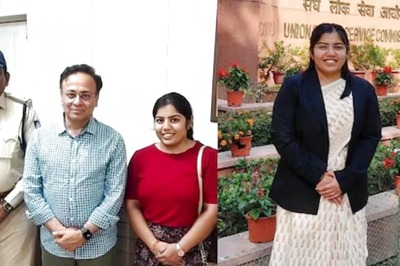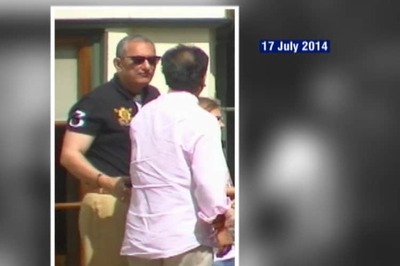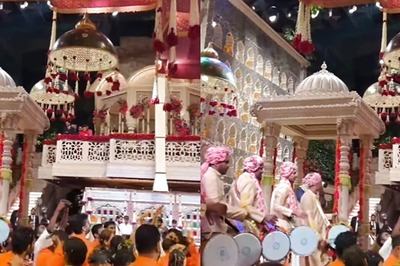
views
Trinamool Congress lawmaker Mahua Moitra said on February 3, 2022, in her parliamentary speech that the government wants to alter history. “Netaji’s Indian National Army’s insignia was Tipu Sultan’s springing tiger–the same Tipu Sultan you erase from our textbooks, after whom you cannot bear to name sports stadiums or roads,” she said.
Her argument, or rather conjecture, falls flat when vetted and sifted closely with an objective lens of history and facts.
If Marxist historians taught a mythical narrative where Tipu, a self-proclaimed “cleanser” of the “infidels”, was considered the beacon of tolerance for over a century, there is much truth in the ironic saying that “yahi toh khoobsurti hai iss desh ki”. Therefore, this would be a good time to appraise the entirety of Tipu Sultan’s reign because, as American philosopher George Santayana once said, “Those who do not learn from the past are condemned to repeat it.” Tipu’s religious fanaticism and reign of terror require no source other than Tipu himself. The following are excerpts from Selected Letters of Tipu Sultan, by W. Kirkpatrick, 1811:
1. In the manifesto of Tipu Sultan: “Whoever refuses to obey would be treated as an accursed infidel, and the Muslims must come together to convert the infidels and wage ‘jihad’.”
2. In a letter to Abdul Kadir: “Over 12,000 Hindus were honoured with Islam. There were many Namboodri Brahmins among them. This achievement should be widely publicised among the Hindus. Then the local Hindus should be brought before you and converted to Islam. No Namboodri Brahmin should be spared.”
3. In letters to Zuman Khan: “You did right in causing a hundred and thirty-five of them to be circumcised. Demolish the fort of Killoor. Seize upon the disturbers of the country, and incorporate them with the Ahmedis (i.e., make Musulmans of them).”
4. In a letter to the army chief in Calicut: “I am sending two of my followers with Mir Hussain Ali. With their assistance, you should capture and kill all the Hindus. Those below 20 may be kept in prison, and 5,000 of the rest should be killed from the tree-tops. These are my orders.”
5. In a letter to Runmust Khan: “Immediately on our hearing of this circumstance, we proceeded with the utmost speed, and, at once, made prisoners of forty thousand…and incorporated them with our band of Ahmedies.”
Not only Hindus, but Tipu’s religious xenophobia extended to Christians as well:
1. After his death in 1799 in the Fourth Anglo-Mysore War and the fall of his capital Srirangapatna to the British, Colonel William Kirkpatrick discovered more than two thousand letters in his palace in Tipu’s own handwriting. Tipu refers to Hindus as “kaffirs” and the British as “Christians” in these letters, both of whom must be “cleansed if the rule of Islam is to be firmly established in India”.
2. Paolino da San Bartolomeo, an Austrian traveller who happened to be in the vicinity of Tipu’s campaign around 1790, wrote (in A Voyage to the East Indies): “Tipu was riding on an elephant behind which another army of 30,000 soldiers followed. Most of the men and women were hanged in Calicut. The first mothers were hanged with their children tied to the necks of their mothers. That barbarian, Tipu Sultan, tied the naked Christians and Hindus to the legs of elephants and made the elephants move around till the bodies of the helpless victims were torn to pieces.”
American historian Will Durant rightly said, “The Islamic conquest of India is probably the bloodiest story in history.” Genocide denial is a crime in many European countries and can be prosecuted under law. Dare I say, there is no difference between Tipu apologists and holocaust deniers? And yet, parliamentarians, like Mahua Moitra, exhort us to name roads after Tipu Sultan so as to lionise the debasement and celebrate the humiliation of centuries of persecution of the Hindu community.
Furthermore, accusing PM Modi of curbing individual freedom, Moitra said, “You fear a future India that is comfortable in its own skin, which is comfortable with conflicting realities. So you’re afraid of an India where a Jain boy can run away from home and eat kathi kabab on a street cart in Ahmedabad. So you forbid non-vegetarian street food in Gujarat’s municipalities.” While Mahua, the TMC MP from Bengal, eulogises an invader and a declared bigot, she annuls the foundational principles of Jainism, carried most notably by Vardhamana Mahavira, that originated in India and once had Bengal as its cradle. Archaeological remains clearly testify that Jainism was a living religion in Bengal and witnessed the beginning of Jainism during the lifetime of Mahavira, who preached his tenets.
Jainism outlines kindness to all living beings, clearly abstaining the Jains from violence, resulting in the Jains’ practising vegetarianism. The ethos believes that moksha can be attained by living a nonviolent life with an as little negative impact on other life forms as possible. In fact, according to Pew Research, roughly nine-in-ten Indian Jains (92%) identify as vegetarian, and two-thirds of Jains (67%) go further by abstaining from root vegetables such as garlic and onions, in order to pursue ahimsa. This self-discipline doesn’t end here. These dietary practices extend outside the home; more than eight-in-ten Jain vegetarians also say they would not eat food in the home of a friend or neighbour who is a non-vegetarian (84%) or in a restaurant that serves non-vegetarian food (91%). It also states that Jains have a lot in common with the Hindus and this falls synergistically with the ruling of the Supreme Court in 2005: “Jainism, Sikhism, and Buddhism are distinct religions, but are interconnected and interrelated to Hindusim, so these three are part of a wider broader Hindu religion, based on the historic background of how they came into existence after.” Mahua’s insinuation that the Jains enjoy non-vegetarian food ‘secretly’, for her (skew) political gains, has not only lacerated the community’s sentiments, but also negated the ethos carried forward by Mahavira, who emphasised the importance of self-discipline and ascetic life as the key to salvation, or moksha.
The two cases above starkly remind us how innately far we are from reality, but Mahua Moitra isn’t alone to blame. Decades of concerted efforts by Indian leftists, communists, Marxist intellectuals, and Nehruvian-secularist historians—basically, all those struck by Solzhenitsyn Syndrome—have white-washed the gory reign of the celebrated ‘Secular King’ Tipu Sultan. This baton today has been passed on to the many politicians, new age ‘historians’ and digital news portals that specialise in whitewashing historical realities to contrive concocted narratives. The constant reminders by this clique serve in three ways. First, the Hindus live forever drowning in ridicule and self-loathing, feeble and meek. Second, the glorification of historical injustices and eulogisation of Tipu and the likes inveigles the Muslim community’s votes. Third, it rehabilitates the scrofulous past, again and again, keeping the cycle fresh despite the copiously documented misdeeds of these bigoted tyrants.
We, as people, are not aware of our own history, and therefore, we’re constantly searching for the truth, but in empty wells. It is important to know what our country has already endured, so that we can carve out a better future, instead of being stuck in a limbo not of our own making. As popularly asked, “Should we be rewriting history just to make (certain) people feel good? That’s not history, that’s psychiatry.” It’s about time we studied history scientifically and with integrity.
Yuvraj Pokharna is a Surat-based educator, columnist, and social activist. The views expressed in this article are those of the author and do not represent the stand of this publication.
Read all the Latest Opinions here




















Comments
0 comment